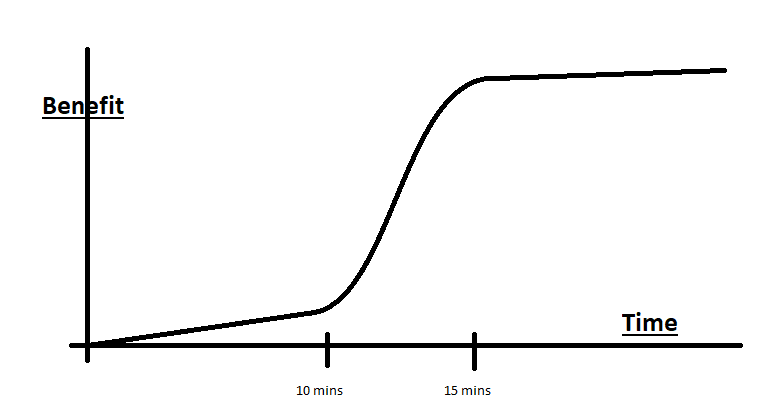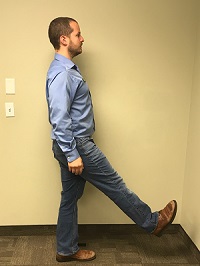Congratulations on taking the next steps in your journey to optimal correction! Chiropractic is based on principles - healing, health and really everything good in life happens from above-down-inside-out. The main function of your spine is to work with your brain and protect your spinal cord so that you have the best ability to adapt and respond appropriately to your environment. What happens when you are subluxated? Nerve interference, reduced brain activation, compensation and degeneration. Your posture, the structure of your spine becomes compromised and you develop habits and patterns of movement that enable you to compensate!!!
The first three exercises listed below are habits that every single person should be engaging in daily to ensure a healthy and stable spine. Please speak with our Technical Chiropractic Assistant to determine which additional exercises are best suited for where you are on your health journey!
Reduced front brain activation = weak stabilizer muscles = reduced diaphragm contraction = high chest breathing (less oxygen, energy, focus, sleep, etc). Think of a string attached at the top of your head, pulling you into an upright position – this will help you engage your stabilizing muscles. Take a deep breath into your belly with your shoulders relaxed (do not intentionally elevate them). This is the postural engagement required when doing any activity to prevent relapse! Take 10 deep breathes in, followed by 10 longer breathes out. Do this 5 times a day.
Walking or running, engaging in this upright cross crawl pattern of movement, is one of the best things you can do to facilitate and maintain curve correction. How long/far do you walk/run each day? You know how many people aim for 10,000 steps right? Ideal is said to be approximately 24,000! Now I know that’s quite the target, but the point is the more we do the healthier we’ll be! The main reason is that it’s the best way to engage your extensor muscles and get your head back on top of your shoulders, it strengthens the stabilizing muscles of your spine! Stand tall like you would for Diaphragmatic Breathing, which will promote proper foot strike and glute activation.
Standing tall, extend your arm out in front of you and place thumb at eye level. Follow thumb nail with your eyes as you bring your thumb up and around, corkscrewing upward while keeping feet planted. Ensure you are not dropping your head down while turning – keep eyes level as you focus on your thumb. Hold for 1s and repeat 5 times on each side, 5 times per day.
Foot strike: outside of forefoot 1st, then inside of forefoot, followed by heel.
Stride: shorter stride length for distance running or walking.
Posture: upright with head atop of shoulders.
Aim to spend 10 minutes walking backward a day. Start off slow to ensure no falls and a smooth symmetrical stride and build up to a speed that you would normally walk forward. Walking backward is a powerful way of stabilizing your lower back, hips, knees, and ankles.
The mark on your cervical x-ray indicates where you are to place the apex of the denneroll.
Initially it will take some getting used to. Start small and be consistent – 6 days a week. 30 seconds to a minute and then increase that time approximately twice per week. For most people it’s uncomfortable (although some love it from day 1), so to reduce the discomfort, rock your head slowly from side to side every 30seconds to a minute as this will spread the stretch across the front of your neck and massage the muscles at the back. When you are finished, roll onto your side and get up that way.
Now the insert suggests 20mins however the most significant benefit has been reached by 15 minutes so that’s your aim for each time you are on the denneroll.

Once you get up, perform your thumb tracings on both sides at least 5x each side and go for a walk.
Standing on one leg, raise the other leg straight out in front of you. Stand tall and lengthen your spine as you would for Diaphragmatic Breathing, ensuring both legs are fully extended straight. Maintain this upright position for the entire exercise without slumping at any point. Your body weight should be shifted back towards the heel of the grounded foot, not the toes. With the raised leg, pull your toes back towards you; stretching the calf behind your knee.

Challenge yourself by holding this position as upright as possible, for as long as possible. Set a time goal and aim to beat it each session. Don’t forget to train both sides!
Standing up, back against a wall. Maintain an upright relaxed posture throughout the movement. Arms extended with your palms facing out – feel the stretch across the front of your chest and down your arms. Raise your arms palm to palm then reach up as far as possible. Bring your arms down pulling your elbows close to your sides.
Perform 10 repetitions, 5x a daily.
Text
Text
Text
Maintaining your ideal posture, take as big a step as you are capable and bring your back knee as close to the floor as you can. Keep your hips forward, feeling some stretch into the front of your back thigh (hip flexor) at the bottom of the movement. Perform these walking forward at the end of your walk/exercise for 20, 30, 50 steps daily, or challenge yourself to hold the deep position of the lunge for a time goal (2min is a good goal). Doing either while holding weights helps condition the shoulders and postural muscles as well!
Grabbing onto a bar a bit wider than shoulder width apart, lift your feet off the ground and hang. If unable to support your full body weight, simply try bending your knees as far as you can while taking some weight off the ground. A good initial goal to reach is a 1min hold. For good athletic conditioning, a 2min+ goal is ideal.
Text
Text
Get on exercise ball, belly down (ball should sit on stomach/crease of hips), feet against the wall. Curve body forwards around the ball, then push hips in and contract back muscles to extend backwards (pull body off ball). Arms should be out to your side.
Perform 10 repetitions, 5x daily.
Text
Belly down on ground with arms out to your sides, thumbs pointing towards the ceiling. With spine neutral, flex the muscles between your shoulder blades to bring arms up off the ground (while extending your spine). Hold up for a couple of seconds, release, and repeat. Perform this exercise with arms extended straight overhead (‘Y’), elbows bent (‘W’), and arms extended straight out to the sides (‘T’).
Repeat 5 times in each position, for a total of 15 repetitions daily.
On your hands and knees, arch your back by lifting your hips, shoulders and head to look forward as you allow your stomach to drop. Hold for 2 seconds. Round your back upwards, drawing in your hips. Allow your head and neck to drop. Hold for 2 seconds. Repeat this sequence for 1min.
Laying down, lengthen your spine and press your lower back into the ground. Bring your knees over your hips, and raise your arms directly upwards. This is your starting position. In a controlled motion, straighten out one leg to the ground while simultaneously lowering the opposite arm overhead. Return them to the starting position and repeat 10 times, switching sides as you go. Make this exercise more challenging by not allowing the lowered arm and leg to touch the ground.
With a long spine on your hands and knees, raise one arm while simultaneously extending the opposite leg back behind you. Lower back down in a controlled motion. Repeat 10 times, alternating on both sides.
With long spine, hold yourself in a push-up position with hands directly under your shoulders. Hold for 10 seconds. Repeat 5 times. Aim for longer holds. Always hands, not elbows, because it’s your hands that you work with and not your elbows. For a side plank, start fully extended on your side, with your hand and outside of leg on the ground. Raise your hips off the ground until your feet, hips, and shoulders are in line together. Hold for 10 seconds. Repeat 5 times on both sides. Aim for longer holds.
Start on your back, with knees bent and your feet flat on the ground. Pressing into your heels, raise your butt off the ground and hold for 2 seconds. Repeat 10 times. For a more challenging variation, try one leg at a time with the other leg extended straight in line with body!
Starting on your back, bend one knee (foot flat on ground) while keeping the other leg extended straight. Place both of your hands under your lower back. Leading with your chest, lift your head and shoulders off the ground a few inches. Hold for 2 seconds, then relax. Repeat 10 times.
Start on your hands and toes in a push up position. Bring one leg across and under the other, extending it out to the side. Simultaneously raise the opposite arm and extend it above you. In a controlled movement, return to the pushup position. Repeat 10 times, switching sides as you go. For a greater challenge, try increasing the tempo of the movement, and complete for 20 repetitions.
Text
Text
Text
Text
Text
Text